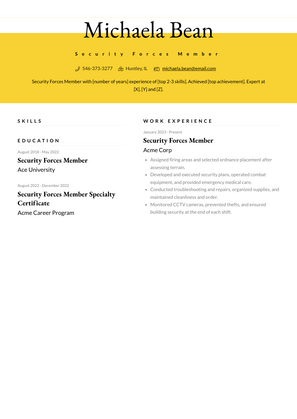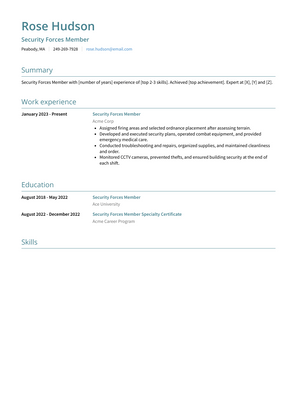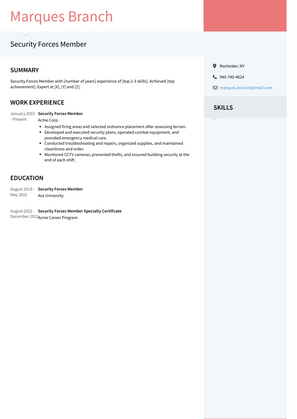Security Forces Member Resume Examples and Templates
This page provides you with Security Forces Member resume samples to use to create your own resume with our easy-to-use resume builder. Below you'll find our how-to section that will guide you through each section of a Security Forces Member resume.



How to Write a Security Forces Member Resume?
To write a professional Security Forces Member resume, follow these steps:
- Select the right Security Forces Member resume template.
- Write a professional summary at the top explaining your Security Forces Member’s experience and achievements.
- Follow the STAR method while writing your Security Forces Member resume’s work experience. Show what you were responsible for and what you achieved as {a/an} Security Forces Member.
- List your top Security Forces Member skills in a separate skills section.
How to Write Your Security Forces Member Resume Header?
Write the perfect Security Forces Member resume header by:
- Adding your full name at the top of the header.
- Add a photo to your resume if you are applying for jobs outside of the US. For applying to jobs within the US, avoid adding photo to your resume header.
- Add your current Security Forces Member to the header to show relevance.
- Add your current city, your phone number and a professional email address.
- Finally, add a link to your portfolio to the Security Forces Member resume header. If there’s no portfolio link to add, consider adding a link to your LinkedIn profile instead.
Bad Security Forces Member Resume Example - Header Section
Caroline 90 Foster Ave. Peabody, MA 01960 Marital Status: Married, email: cooldude2022@gmail.com
Good Security Forces Member Resume Example - Header Section
Caroline Mendez, Peabody, MA, Phone number: +1-555-555-5555, Link: linkedin/in/johndoe
Make sure to add a professional looking email address while writing your resume header. Let’s assume your name is John Doe - here is a formula you can use to create email addresses:
- firstnamelastname@email.com - johndoe@email.com
- firstname.lastname@email.com - john.doe@email.com
- lastname.firstname@email.com - doe.john@email.com
- f.lastname@email.com - j.doe@email.com
- l.firstname@email.com - d.john@email.com
- firstnamelastname12@email.com - johndoe12@email.com
For a Security Forces Member email, we recommend you either go with a custom domain name (john@johndoe.com) or select a very reputed email provider (Gmail or Outlook).
How to Write a Professional Security Forces Member Resume Summary?
Use this template to write the best Security Forces Member resume summary: Security Forces Member with [number of years] experience of [top 2-3 skills]. Achieved [top achievement]. Expert at [X], [Y] and [Z].
How to Write a Security Forces Member Resume Experience Section?
Here’s how you can write a job winning Security Forces Member resume experience section:
- Write your Security Forces Member work experience in a reverse chronological order.
- Use bullets instead of paragraphs to explain your Security Forces Member work experience.
- While describing your work experience focus on highlighting what you did and the impact you made (you can use numbers to describe your success as a Security Forces Member).
- Use action verbs in your bullet points.
Security Forces Member Resume Example
Security Forces Member
- Assigned firing areas and selected ordnance placement after assessing terrain.
- Developed and executed security plans, operated combat equipment, and provided emergency medical care.
- Conducted troubleshooting and repairs, organized supplies, and maintained cleanliness and order.
- Monitored CCTV cameras, prevented thefts, and ensured building security at the end of each shift.
Top Security Forces Member Resume Skills for 2023
- Physical Fitness and Endurance
- Firearms Training
- Security Patrol Techniques
- Surveillance and Observation
- Emergency Response Procedures
- Close Quarters Battle (CQB) Tactics
- Access Control Procedures
- Use of Defensive Equipment (Batons, Handcuffs, etc.)
- Physical Security Assessments
- First Aid and CPR Training
- Radio Communication
- Use of Security Systems (CCTV, Alarms)
- Crowd Control Techniques
- Security Risk Assessments
- Investigation Techniques
- Search and Seizure Procedures
- Knowledge of Security Laws and Regulations
- Understanding of Rules of Engagement
- Legal and Ethical Standards in Security
- Threat Assessment
- Physical Restraint Techniques
- Counter-Terrorism Measures
- Use of Non-Lethal Weapons
- Risk Management
- Team Coordination and Communication
- Incident Reporting and Documentation
- Emergency Evacuation Procedures
- Response to Hazardous Materials
- Understanding of Cybersecurity Threats
- Information Security Protocols
- Use of Biometric Access Systems
- Protective Services for VIPs
- Counterintelligence Awareness
- Understanding of Physical Security Barriers
- Adaptability to New Security Technologies
- Knowledge of Explosive Detection Techniques
- Use of Handheld Security Devices
- Security Intelligence Gathering
- Facility Security Planning
- Behavioral Analysis Techniques
- Chemical, Biological, Radiological, Nuclear (CBRN) Defense
- Use of Unmanned Aerial Systems (UAS) in Security
- Understanding of Security Threat Levels
- Knowledge of Emergency Communication Systems
- Understanding of Workplace Violence Prevention
- Fire Safety and Evacuation Procedures
- Use of Handheld Metal Detectors
- Physical Defense and Hand-to-Hand Combat Training
- Knowledge of International Security Protocols
What Do Hiring Managers Look For in a Security Forces Member Resume?
‣ Security Protocols: Security forces members must be well-versed in security protocols, including access control, surveillance, and emergency response procedures to maintain a secure environment.
‣ Physical Fitness: Maintaining a high level of physical fitness is crucial for security forces members, as they may need to respond quickly to security threats and emergencies.
‣ Crisis Management: The ability to effectively manage and respond to crises, including assessing situations, making quick decisions, and implementing appropriate security measures to ensure the safety of personnel and assets.
‣ Communication Skills: Clear and concise communication is essential for security forces members to relay information, coordinate responses, and work effectively as a team.
‣ Adaptability: Being adaptable to changing security situations, adjusting strategies and tactics as needed, and staying vigilant to prevent and respond to potential threats effectively.
How Long Should my Security Forces Member Resume be?
Your Security Forces Member resume length should be less than one or two pages maximum. Unless you have more than 25 years of experience, any resume that’s more than two pages would appear to be too long and risk getting rejected.
On an average, for Security Forces Member, we see most resumes have a length of 2. And, that’s why we advise you to keep the resume length appropriate to not get rejected.
Copyright ©2025 Workstory Inc.
